April 5 - 18, 2015: Issue 209
The Crinoline - a 550 Year Old Fashion
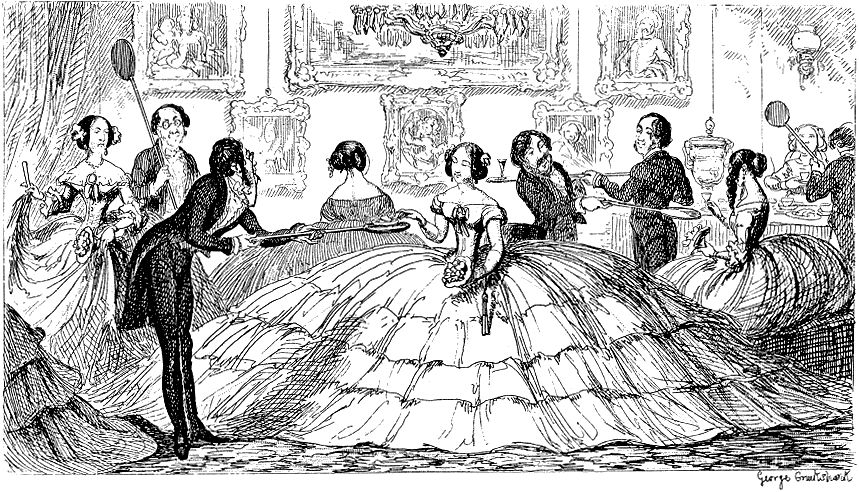
"A Splendid Spread", satire on an early inflatable (air tube) version of the crinoline by George Cruikshank, from The Comic Almanack, 1850. (Crinolines did not actually come into wide use until a few years later.) Note that the gentlemen have to use long-handled trays ("baker's peels") if the ladies are to be able to eat or drink.
Many people attest to the changeability of what is fashionable and ‘fashion’. With puns and derogatory remarks set aside, even though very few could proclaim that they have not been caught up by some whim of dress, style of hair, foot clobber when growing (who hasn’t cleaned out their wardrobe stating “I can’t believe I used to wear that”? - and isn't referring to a much tinier size), very few of these garments have stood the test of time and usefulness to still be in use today.
One fashion that has had more then a little derision levelled at it, but is still being made, still being worn, is the crinoline. A recent expedition into a mother’s wardrobe showed one such tiered net of petticoat with hoops diminishing, a definite skirt fluffer-outer that apparently not only went under a Debutante dress and then Wedding dress, but was also loaned out to others who had need of ensuring gowns were suitably voluminous as per their original styles, and is of that quality that ‘cannot be bought today’. Said crinoline is a 1950's version, the decade which of course saw wonderful flaring skirts as much as close tailored suits like those 'fashioned' by Chanel.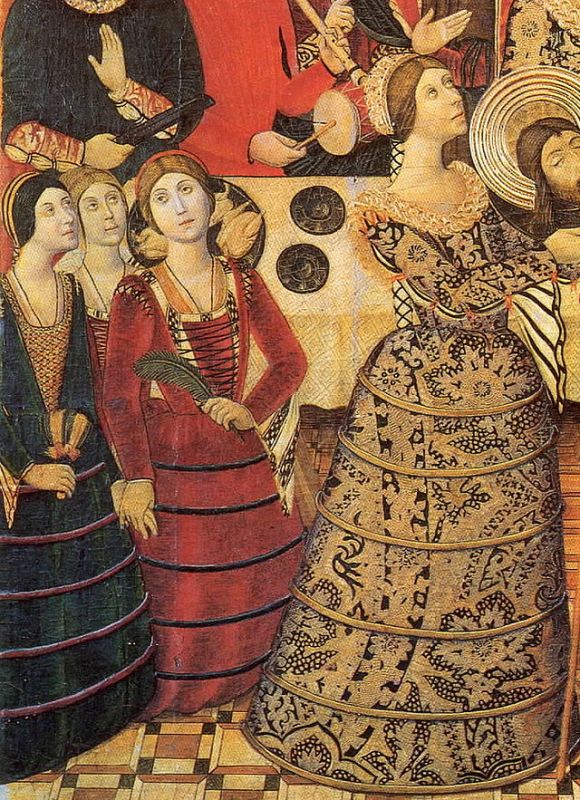 You can and people still do buy crinolines: long versions, shorter versions for dancers, people attending formals, and some wedding dresses still require hoops or ball gown style crinolines, petticoat crinoline slips, a ‘mermaid’ style crinoline – named for its shaping, and even versions that are worn without any skirt as a new 'fashion' in itself!
You can and people still do buy crinolines: long versions, shorter versions for dancers, people attending formals, and some wedding dresses still require hoops or ball gown style crinolines, petticoat crinoline slips, a ‘mermaid’ style crinoline – named for its shaping, and even versions that are worn without any skirt as a new 'fashion' in itself!
Although vintage clothes now command high prices, new versions of this ancient petticoat can be had quite reasonably.
Today they’re made of taffeta, or cotton and plastic. The 1950’s version still held by a collector of fashions so classic they’ve never actually gone out of fashion, is made from strong linen and lighter coils of steel.
The precursors were made from linen too, with a ‘weft’ or horse hair and stiffened by hoops made of rope, wires and even poor whale’s bones. The word itself comes from: C19: from French, from Italiancrinolino, from crino horsehair, from Latin crīnis hair +lino flax, from Latin līnum.
The farthingale, which originated in Spain, was the precursor to the crinoline and described as ‘any of several structures used under Western European women's clothing in the 16th and 17th centuries to support the skirts in the desired shape’.
The French farthingale, also known as the wheel farthingale, originated in court circles in France; it was introduced in the late 1570s to England.
Randle Cotgrave, in his Dictionaire of the French and English Tongues (1611), defined the French farthingale as “the kind of roll used by such women as weare no Vardingales.” Several wardrobe accounts and tailors' bills of the late sixteenth century give us an idea of what these rolls were made of: they were stuffed with cotton and rags, and stiffened with hoops of whalebone, wire or ropes made of bent (a small reeds) Buckram (stiff canvas) is the most commonly mentioned material. Other references describe the rolls being starched.
Here are a couple of sample references to rolls from Queen Elizabeth I's Wardrobe Accounts (MS Egerton 2806):
“[for] making of thre rolles of hollande clothe with wyers bounde with reben (1585)
making of a rolle of starched buckeram with whales bone (1586)
Crinoline first appeared around 1830, but by 1850, the word meant a stiffened petticoat or rigid skirt-shaped structure of steel designed to support the skirts of a woman's dress into a wide required shape. In 1858, an American W.S. Thomson greatly facilitated the development of the cage crinoline by developing an eyelet fastener to connect the steel crinoline hoops with the vertical tapes descending from a band around the wearer's waist. The invention was patented in the United States (patent US21581), France (patent FR41193) and Britain (patent GB1204/1859). This facilitated the fashionable silhouette's development from a cone shape to a dome. It was not an entirely original idea; Thompson was probably inspired by the open cage or frame style of farthingales and panniers.
The cage crinoline was adopted with enthusiasm: the numerous petticoats, even the stiffened or hooped ones, were heavy, bulky and generally uncomfortable, while the crinoline was light—it only required one or two petticoats worn over the top to prevent the steel bands appearing as ridges in the skirt—and freed the wearer's legs from tangling petticoats. (1.)
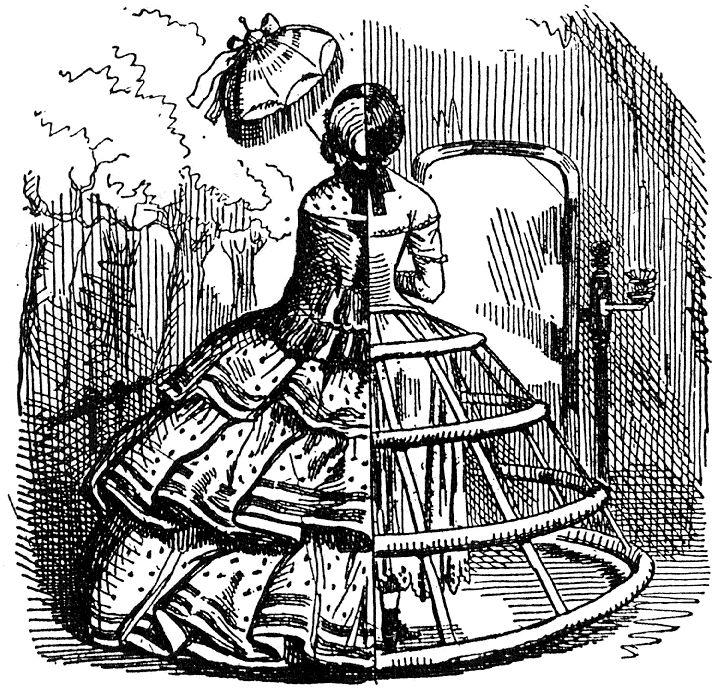
CRINOLINE AND FIRE.
TO THE EDITOR OF THE EMPIRE.
Sir,-An inquest was recently held on the remains of a young woman, who met a shocking fate through wearing crinoline ; similar cases are of frequent occurrence. How suicidal is the conduct of females, who complying with a foolish and dangerous custom, bring upon themselves so fearful a death-being roasted
alive.
In the case alluded to above, the victim was only fifteen years of age. Having made a fire in the yard to boil water for washing, her clothes, extended with crinoline, catches fire ; she rushes into the house enveloped in flames : in vain her master tries to extinguish the fire, and save the girl; the crinoline renders this impossible-it cannot be compressed – the victim has secured her own destruction ; her master has a narrow escape-his hands and arms are badly burnt. Surely, Sir, this ought to ho a warning to all wearers of crinoline. They ensure their own destruction, and expose to great danger, any person rendering assistance If servants are so foolish to incur danger in this way, employers must interfere ; and if the ladies would enforce some rule that would at least prevent their servants wearing extensive crinolines while engaged in domestic- duties, the recurrence of so many fearful and fatal burnings might be prevented. Some precaution is certainly needful, for the servants expose with themselves the family to imminent danger. In the above case, it was most fortunate the master was at home. The victim made to the room where the mistress and children were. I hope attention will be drawn to this, and trust, such heart-rending scenes may,
be less frequent
ONE OF THE JURY. CRINOLINE AND FIRE. (1865, November 14). Empire (Sydney, NSW : 1850 - 1875), p. 5. Retrieved fromhttp://nla.gov.au/nla.news-article63239552
After the 1860’s the shape changed to accommodate more flexibility and less ‘circumference’. The dome shape was modified to fit closer at front and sides and flare out at the back only.
Satirists such as those who published Melbourne Punch may be held accountable for some of the more hilarious references to the most ostentatious phases of this petticoat as well as keeping a record of those who, literally, fell victim… to fashion:
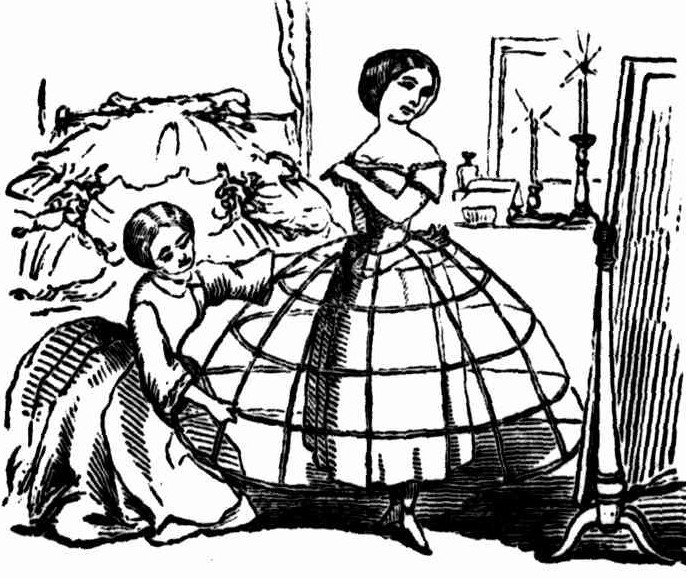
Miss X. TENSIVE seconded the motion, contenting herself with remarking that she trusted her opinion of crinoline had always been sufficiently evident to render any merely verbal expression of her sentiments unnecessary. (Hear.)The motion was put and carried nan. con.
Mrs. SHEEDE WRAGGON said she was there to propose the next resolution, and she would do it, spite of the press, or anyone else.(Hear, hear.) What had the press to do with crinoline? (Hear, hear, hear.) Expansion was what she liked, and as for the press, she for one thought the Government should suppress it. ("Oh ") She did not care for "ohs," not she. (Here the lady sitting next to Mrs. Wraggon stooped over as near to her as possible, and addressed her in a loud whisper. Mrs. Wraggon resumed.) A friend had told her that the "oh" was directed at a pun she had unconsciously made. All she could say was, she hated puns, and, if she had uttered one, apologised. The press was chiefly conducted, she believed, by men, and that accounted for its attacks upon crinoline. Her husband was a man (a laugh), and he had dared to sneer at crinoline. He was sufficiently a brute to repeat frequently what he avowed was a classical expression made by one Catto, or some such, name, to the efteet that " Crinoline had increased, was increasing, and ought to be destroyed." (Groans.) He had not gained much by the practice, as of late every time he gave utterance to that odious sentiment she purchased a new crinoline larger than the last. (Loud applause.)She trusted that, if at any time, she appeared with what might be deemed unnecessarily extensive skirts, the little domestic incident she had referred to would yield ample excuse. (Hear, hear.) She begged to move—"That, inasmuch as some of the male sex complained of want of room in buildings and streets frequented by ladies, owing to the present style of feminine attire, a petition be presented to both Houses of Parliament demanding that such buildings and streets be immediately enlarged."
Miss H. IKKEN, in seconding the motion, observed that crinoline was a "duck of a fashion," and she hoped it would last till she was an old woman. This resolution, like the last, was carried unanimously, and a petition having been duly drawn up and adopted, a vote of thanks was awarded Miss Fashionissima Phipps for her admirable conduct on the form, and the meeting (with some difficulty) separated.
THE CRINOLINE MOVEMENT. (1863, March 26). Melbourne Punch (Vic. : 1855 - 1900), p. 1. Retrieved from http://nla.gov.au/nla.news-article174528388
The crinoline moved into other uses a mere 40 years on:
CRINOLINE.
According to an enthusiastic New York lady, the crinoline has at length asserted its uses, and made good its chum to be taken seriously. Only a few weeks ago the newspapers told how cruelly women were jostled by crowds of hurrying business men oil the stairways and platforms of the elevated and underground railways. A girl, it was said., was seriously injured in one of these stampedes: but now retribution has been found in the old-fashioned crinoline. Wearing one of these, a woman can take entire possession of the staircase, and no matter how leisurely her steps, the burly and self-assertive man heading a crowd behind her cannot hurry her. He may dodge from tide to side, and prepare for a rush and a spring past her. but that simple crinoline keeps him at -bay as officially as a platoon of soldiers would. He may dance with impatience and annoyance as visions of the train he has missed-owing to his love of setting things some what finely flash before him, still the serene damsel walks calmly on, barricaded by her invincible hoop. At present the feminine part of New York are considering very seriously whether, alter all. it would not be to their advantage to adopt forthwith so effective a protector as this mysterious little deu'-e of ho'f, is and ribbons, upon which so much obloquy has been heaped.
Canterbury Times. CRINOLINE. (1906, September 22). Observer (Adelaide, SA : 1905 - 1931), p. 7. Retrieved fromhttp://nla.gov.au/nla.news-article163077315
And remains a part of many a wardrobe today, used as aforementioned. No one could deny a lady swishing out broad skirts that taper to a thus thinned waist does not look lovely, whether twirling around a dance floor, gliding across a lawn at a garden party, or walking down the aisle.
Perhaps the most quirky of stories associated with this fashionable clothing item is how it saved the life of one wearer; Tthe case of Sarah Ann Henley, who jumped off the Clifton Suspension Bridge, Bristol, in 1885 after a lover's quarrel, purportedly survived the fall of almost 75 metres (246 ft) because her skirts supposedly acted like a parachute and slowed her descent. Debate reigned over whether the skirt actually saved Henley from the fall, the story, however, became a local Bristol legend, perhaps superseded by the wags at Melbourne Punch again:
CRINOLINE.
May blessings light on her whose mind,
Unused to cogitations mean,
Invented that sublimely grand
Circumference called crinoline.
For once a whirlwind rais'd me up,
And bore me through the blue serene,
Yet no balloon a safer flight
Could take, than did my crinoline.
Again, how many fops would fain
Have me upon their arm to lean,
But, ah! I hold them all aloof ,
With fence of outspread crinoline.
Whene'er I see the full-orb'd moon
Shed o'er the night her silv'ry sheen,
I murmur " Lo! an angel robed
In rich array of crinoline."
O, circle large! O, matchless sphere!
Environing both fat and lean,
How could the streets be swept if we
Forewent the use of crinoline ?
CRINOLINE. (1862, January 30). Melbourne Punch (Vic. : 1855 - 1900), p. 3. Retrieved from http://nla.gov.au/nla.news-article174527209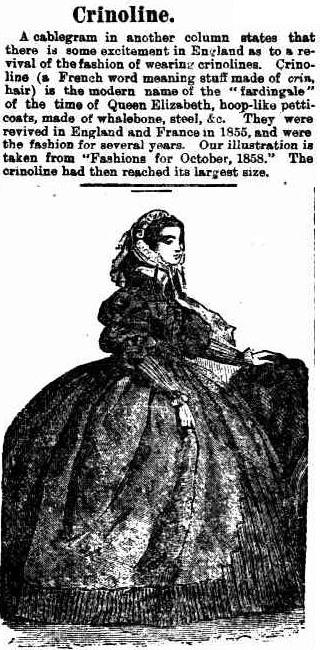 References
References
Fashion from Middle English facioun, from Old French façon, appearance, manner, from Latin factiō, factiōn-, a making, from factus, past participle of facere, to make, do;
1. Crinoline. (2015, March 7). In Wikipedia, The Free Encyclopedia. Retrieved fromhttp://en.wikipedia.org/w/index.php?title=Crinoline&oldid=650223924
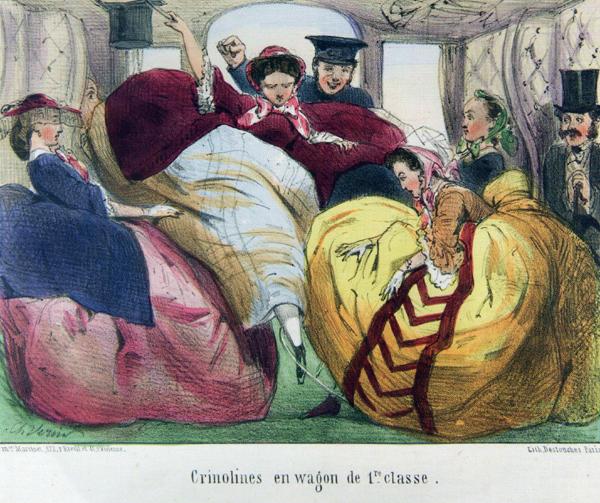
CRINOLINE.
Sir,-As I was strolling down Sturt street past the Mechanics' Institute, yesterday evening, after the labors of the day, I thought I would step in and take a look at the Horticultural Society's flower show, then being held in the large hall of the above named institute. Well, I went in, expecting it would take me only about half-an-hour or so to go round the room and look at the plants, &c., so nicely arranged; but I had not been in above two minutes before I found myself blockaded by a party of young ladies with their immense balloon-shaped appendages. With a great deal of shuffling and pushing, I managed to get out from amongst them; but as fast as I got away from one lot I got amongst another. At last, when I got round to the door again, I found it had taken me over two hours, besides making me perspire as if I bad been in an oven instead of a largewell ventilated room. Now, Sir, I recollect that in London, at the picture galleries and such like places, there used to be a man at the door to take charge of gentlemen's canes, &c. Now I think it would be a good plan to have a room at the entrance, with a female in attendance, so that the ladies may take off their crinolines, and leave them there till they leave the entertainment, or whatever it may be. Hoping you will insert these few words in your valuable paper.
I remain, &c.,"
ANTI-CRINOLINE. CRINOLINE. (1864, November 21). The Star (Ballarat, Vic. : 1855 - 1864), p. 4. Retrieved fromhttp://nla.gov.au/nla.news-article66349881
Article in upper right: Crinoline. (1893, January 24). Evening News (Sydney, NSW : 1869 - 1931), p. 6. Retrieved fromhttp://nla.gov.au/nla.news-article113739181
Previous Collectors Corner pages:
Blacksmiths and Tinsmiths Nylon Stockings Poster Art Furphy's Water Cart Mousehole Anvil Sapphire One Armed Bandit Gould's 1840 Single and Compound Microscope Tibetan Thangka Wheel Of Life Painting Cast Iron Seats Mabel Lucie Atwell Prints The Customs of Traditional Dining by Hans and Jenny Carlborg Albert Collins Landscape Boomerang Harmonicas Drinking: 18th Century Style Part I by H&J Carlborg Drinking 18th Century Style Part II by H&J Carlborg Fleece Shears Wood Case Crank Telephone 1803 Timepeice Vintage Guitars Milestones No.38RollsRoyceMotorOiler Christmas Postcards Seashells McCormick-Deering Horse Drawn Mower Rope Making Machine Marilyn Monroe 1955 Calendar Stubbie Holders Hill's Hoist Akubra Hat Fowler's Bottling Kit The Bold Autographed Script Fishing Tackle Arnotts Biscuit Tins Comic Books Silver Opium Pipe Mrs Beetons Book Souvenir Teaspoons Bendigo Pottery Gianelli Figurines Key Fobs Model Aircraft-static Porcelain Slippers Wagon Wheels Rhys Williams Painting Chinese Guardian Lions Australian Halfpenny Bud Vases Rolling Stones Still Life LP Autographed WL1895 Thinking Monkey Estee Lauder Ginger Jar Reel Mowers Surf Reels Millers Car Collection Hilton Lingerie - Slips Miniature Books of Verse - A Romantic Tradition REGA Pouring Can R O Dunlop - Sailing At Itchenor Painting Morning Shadows by C Dudley Wood The Father of Santa Claus - Xmas 2012 HMS Penguin Anchor at RPAYC - Newport SS Birubi Mast at RMYC - Broken Bay Helen B Stirling Ship's Wheel at Club Palm Beach Woomeras HMSEndeavour Replica Cannon at RPAYC The Doug Crane Classic Handmade Double Blade Paddle HMS BountyWooden Ship Model Collecting Ladies - Ferdinand Von Mueller and Women Botanical Artists Australian Bark Art Chinese Ginger Jars Hand Plough and Jump Stump Plough - Australian Inventions Frank Clune Books Frederick Metters - Stoves, Windmills, Iron Monger Trinket Boxes 1933 Wormald Simplex Fire Extinguisher is Pure Brass Chapman 'Pup' Maine Engines - Chapman and Sherack The Beach Ball Figureheads – Salty Wooden Personifications of Vessels Binnacle at RMYC The Australian Florin - Worth More Than 20 Cents to Collectors Weathervanes; For Those Passionate About Seeing Which Way the Wind Blows Her Majesty’s Theatre 1962 Programme - Luisillo and his Spanish Dance Theatre Cooper's Sheep Shower Enamel Sign and Simpso's and Sons of Adelaide Jolly Drover Sugar Bowl and English Pottery – A Means to Gaze into the Past Chief Joseph and Edward S Curtis; His Remarkable Images of Native Americans – an Inestimable Record of Images and Portrait Photographs His Masters Voice, Old 78’s and Australia’s Love of Music Jack Spurlings 'Tamar' Picture 1923 Resch's Beer Art - A Reflection of Australiana Now Worth Thousands The Compleat Angler - Izaak Walton’s Discourse Inspires Generations of Fishers Portable Ice-Boxes and Coolers – How Many Claim This Invention as Theirs? Malley's and Sons Ltd. - A Munificent Australian Family Company Vintage Paddles and Gigs – Nautical Memorabilia
by A J Guesdon, 2015.